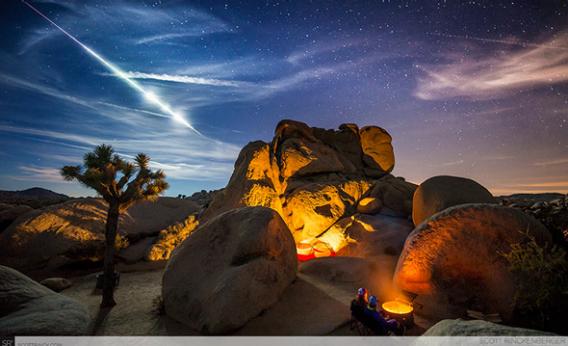Create a free profile to get unlimited access to exclusive videos, sweepstakes, and more!
Playing the Cosmic Odds

There is something to be said for perseverance, for persisting until the last moment you can. You can make a lot of moral and emotional arguments for it, of course, but thereâs also a mathematical one: If you stick around long enough, sometimes the odds, stacked against you as they may be, will break your way.
Scott Rinckenberger is a photographer from Seattle. He was in Joshua Tree National Park, finishing up a five-week trip shooting scenes in the American west. I donât want to spoil the whole story â he tells it well on his own website â but on the last day of the trip he threw the dice one last time⦠and they rolled his way:
This phenomenal shot shows the campsite where he and his friend were staying. Itâs a lovely foreground, and the sky itself lent a fine photogenic backdrop. But as luck would have it, a meteor shot across the field of view during the short 30-second exposure.
Thatâs actually a fairly common occurrence; shooting stars happen several times an hour, especially if youâre in a dark site and can see the fainter ones. But this one was hardly faint! As you can see, it streaked in from the upper left, and shortly before burning out it flared brightly several times.
What we call meteors are actually tiny bits of rock (or sometimes metal) that blaze as they ram through our atmosphere. When you compress a gas it heats up, and when an object moving dozens of times faster than a rifle bullet plows through the air, it violently compresses the gas ahead of it. The air heats up so much it glows. At the same time, the meteoroid â the solid bit of material â itself is undergoing extraordinary pressure. The rock can flatten, pancaking, and crumble under the strain. When it breaks apart there are suddenly several rocks compressing the air ahead of them, which means more surface area to heat up, and more light is generated. Those rocks can also break up, until they are so small they either decelerate and no longer glow, or burn up entirely.
This all happens in a fraction of second at these speeds, and the velocity is so high the energies can be quite large. I expect the rock that Rinckenberger caught with his camera was perhaps no bigger than a grapefruit, but at 30 or more kilometers per second, thatâs all it takes to make a very bright flash in the sky. He caught the whole thing, including the breakup, just barely fitting into the frame.
And not only that, it provides some balance to the picture, offsetting the big rock in the foreground and the airplane seen on the right in the sky.
Iâd say he was lucky, but in this case, luck = (low chance of event) x (plenty of time spent looking). Sometimes luck breaks your way, but if youâre ready for it, and keep plugging away, then you can make the big score.
There is something to be said for perseverance.


























